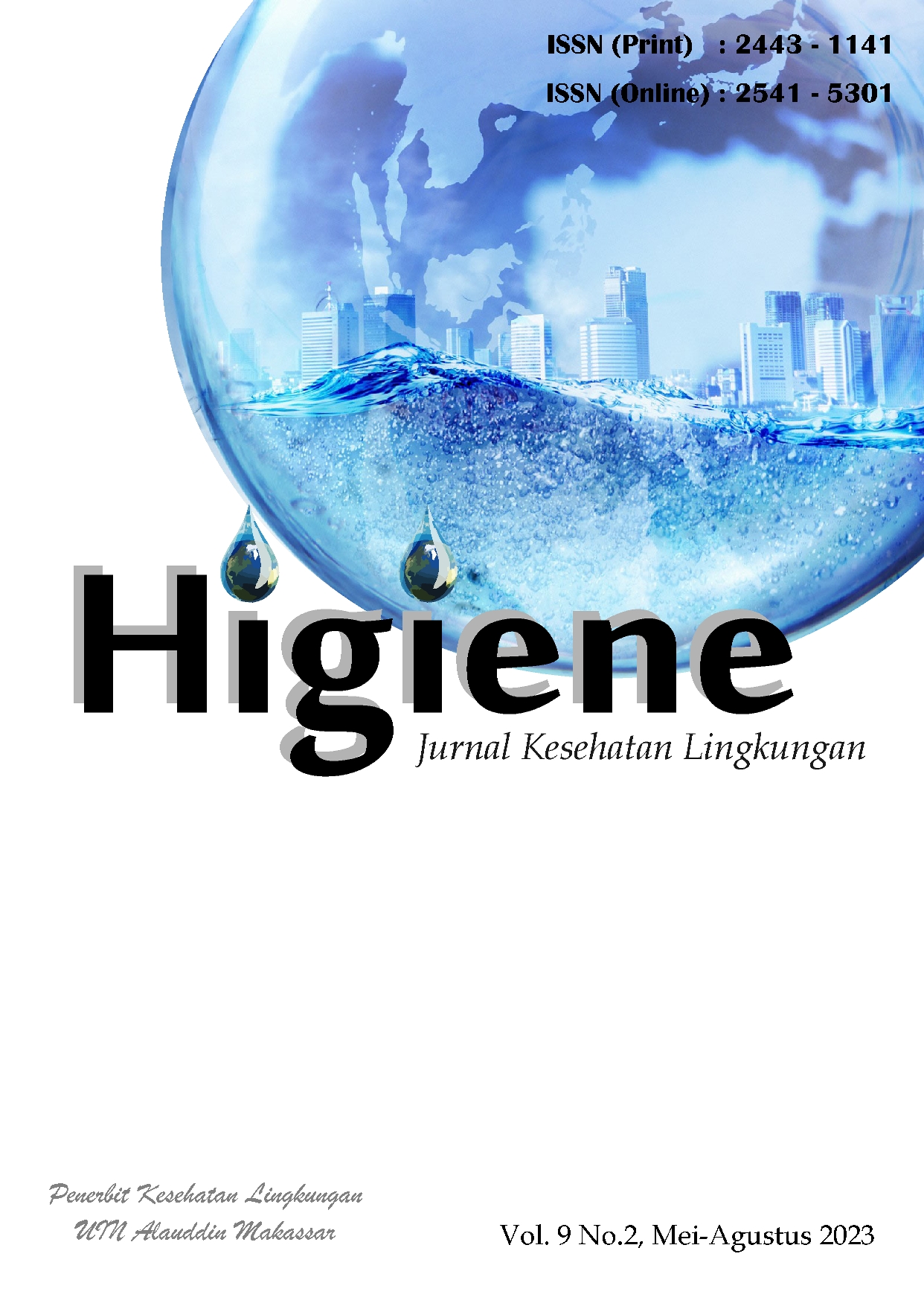Rodentisida Nabati Singkong Mentah (Manihot esculenta) sebagai Alternatif Pengendalian Hama Tikus
Abstract
Rats are nuisance animals that can damage the economy and bring diseases to humans. To control rat populations, rodenticides are often used that contain toxic chemicals that are not environmentally friendly. However, there is an alternative to reducing the use of rodenticides, namely using vegetable rodenticides made from natural ingredients such as cassava which contains cyanide acid. Cyanide acid is very dangerous and can cause illness and even death if ingested. This research is a literature review. Research conducted by Fazriyawati and Rahmawati used 50 male white mice of Mus musculus species as samples. Samples were treated with cassava rodenticide doses of 40 grams, 60 grams, 80 grams, and 100 grams. The results showed that the highest mice mortality occurred at a dose of 100 grams with an average bait consumption of 62.48 grams and a mice mortality percentage of 60%. Thus, the conclusion of this study is that raw cassava has the potential as an effective vegetable rodenticide.
Keywords: Mice, Plant-based Rodenticide, Raw Cassava
References
Alfarisy, M. N., Heiriyani, T., & Saputra, R. A. (2019). Uji Bahan Nabati sebagai Rodentisida Alami terhadap Tikus Jantan. Jurnal Tugas Akhir Mahasiswa, 2(3), 50–57.
Astuti, D. R. (2013). Keefektifan Rodentisida Racun Kronis Generasi II terhadap Keberhasilan Penangkapan Tikus. KEMAS: Jurnal Kesehatan Masyarakat, 8(2).
Devi, S.A.I., et al. (2020). Repellent Activity of Essential Oils Against the House Mouse (Mus musculus L.). Journal of Pure and Applied Microbiology, 14(3), 1715-1723.
Etik Sundari, E. S. (2022). Efektifitas Campuran Umbi Gadung dan Buah Bintaro sebagai Rodentisida Nabati (Doctoral dissertation, Poltekkes Kemenkes Yogyakarta).
Fazriyawati, A. N., Hardiono, H., & Rahmawati, R. (2019). Efektivitas Singkong Mentah (Manihot Esculenta) Sebagai Rodentisida Nabati Terhadap Pengendalian Tikus Mencit (Mus Musculus). Jurnal Kesehatan Lingkungan: Jurnal dan Aplikasi Teknik Kesehatan Lingkungan, 15(2), 661–666. https://doi.org/10.31964/jkl.v15i2.110.
Irawan, A., Heiriyani, T., & Gt. M, S. N. (2017). Berbagai Jenis Umpan Mengandung Larutan Umbi Gadung The Death of White Mice ( Mus musculus ) Given Different Types of Feed Containing Gadung. Prosiding Seminar Nasional Lahan Basah, 1, 217–221.
Lihabi, L. (2017). Pengaruh Perasan Daun Singkong (Manitol esculante) Terhadap Kadar Hemoglobin Pada Mencit (Mus musculus) (Doctoral dissertation, Universitas Muhammadiyah Surabaya).
Lumbantobing, R., Napitupulu, M., & Jura, M. R. (2020). Analysis of Cyanide Acid Content in Cassava (Manihot esculenta) Based on Storage Time. Jurnal Akademika Kimia, 8(3), 180–183. https://doi.org/10.22487/j24775185.2019.v8.i3.pp180-183
Mahfuz, M., Akter, M., Karim, M. R., & Kim, D. H. (2020). Efficacy of Plant-Derived Essential Oils as Repellents, Toxicants, and Protectants Against Xylosandrus Compactus and Xylosandrus Crassiusculus (Coleoptera: Curculionidae: Scolytinae). Journal of Economic Entomology, 113(1), 117-125.
Mrosso, F.P., Sikira, A., Swai, E.S., Ndoe, N.S.Y., Mchau, G.M., & Ndakidemi, P.A. (2020). Rodent Pest Control and Its Implications for Crop Yield in Smallholder Farming Systems in Tanzania. Journal of Agricultural Science, 12(11), 211-221. doi: 10.5539/jas.v12n11p211.
Noerwijati, K., & Budiono, R. (2018). Mengenal Senyawa HCN pada Ubi Kayu. Seminar Nasional Fakultas Pertanian Universitas Muhammadiyah Purwokerto Optimalisasi Sumberdaya Lokal Untuk Mewujudkan Kedaulatan Pangan, 172–182. http://www.milkingredients.ca/index-eng.php?id=197.9/3/2018
Nurjanah, N., & Hidayat, A. (2018). Pengaruh Serangan Hama terhadap Produktivitas Tanaman Padi di Daerah Karawang, Jawa Barat. Jurnal Pertanian Indonesia, 23(2), 81-86.
Purba, W., Sitepu, S. F., & Lubis, L. (2018). Pengujian Beberapa Rodentisida Nabati terhadap Tikus Sawah (Rattus Argentiventer Robb And Kloss) di Laboratorium. Talenta Conference Series: Agricultural and Natural Resources (ANR), 1(1), 47–52. https://doi.org/10.32734/anr.v1i1.95.
Sari, Y. W., & Winarni, N. (2018). Efektivitas Racun Nabati sebagai Rodentisida: Tinjauan Kritis. Jurnal Ilmiah Perikanan dan Kelautan, 10(1), 63-69.
Simões, M.O., et al. (2017). Cyanogenic Compounds in Cassava and Its Preservation: A Mini Review. Emir. J. Food Agric., 29(4), 243-251. https://doi.org/10.9755/ejfa.2016-10-1342
Sulfiani, & Taufiq, N. (2022). Pengaruh Penambahan Zat Kapur dan Lama Perendaman terhadap Kadar Sianida pada Singkong (Manihot Esculanta Crantz). Jurnal Sehat Mandiri, 17(2), 133–141.
Syafitri, A., Yuliatina, D., Hendrawani, H., Azizah, N., Bilad, M. R., Asmiati, S., & Khery, Y. (2021). Pembuatan Pestisida Nabati untuk Meningkatkan Keterampilan Petani Desa Duman Menuju Pertanian Organik. Lumbung Inovasi: Jurnal Pengabdian Kepada Masyarakat, 6(2), 75–82. https://doi.org/10.36312/linov.v6i2.572
Utama, Y. A. K., & Rukismono, M. (2018). Singkong-man VS Gadung-man.
Wahyu Daradjat Natawigena., Ichsan Nurul Bari., Chindera Rindhany Surachman. (2021). Rodentisida terhadap Metabolisme dan Perilaku Tikus Putih (Rattus norvegicus Wistar) Di Laboratorium. 6.
Copyright (c) 2024 HIGIENE: Jurnal Kesehatan Lingkungan

This work is licensed under a Creative Commons Attribution 4.0 International License.


